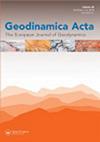土耳其西部Gökçeada岛Mezardere组(始新世晚期-渐新世早期)前三角洲沉积技术
IF 1.5
Q1 Earth and Planetary Sciences
引用次数: 7
摘要
Gökçeada岛Mezardere组以前三角洲相为主,多为浅灰色、薄层状、易裂的钙质泥岩和粉砂岩,多为平行层叠,极少为波纹层叠。这些沉积物与极细或细粒的微白云母砂岩隔层,下部呈平行层状,上部呈波纹层状,或仅呈波纹层状。较厚的砂岩层,被称为河口坝,在一些地方存在。前三角洲沉积物的生物扰动程度较差(ii = 0-1),但在部分层理表面发现了中等多样性的微量化石,包括13个鱼属22个鱼类群和3个开放命名的微量化石。微量化石组合的贫乏是三角洲沉积的典型特征,但前三角洲沉积的微量化石的缺乏和生物扰动的匮乏是显著的。在大多数露头中,典型的海生鱼栖动物很少或不存在。这一化石组合与Mermia岩相相似,表明古环境具有强烈的微咸性;然而,在一个露头中出现库祖恩比科尔长岩表明,当地和时间的正常海洋条件被称为盐度波动。本文章由计算机程序翻译,如有差异,请以英文原文为准。
Ichnology of prodelta deposits of the Mezardere Formation (late Eocene – early Oligocene) in the Gökçeada Island, western Turkey
On Gökçeada Island, the Mezardere Formation is dominated by the prodelta facies composed mostly of light grey, thinly bedded, fissile calcareous mudstones and siltstones, which mostly display parallel lamination or rarely ripple lamination. These sediments are intercalated with isolated thin beds of very fine- or fine-grained slightly muscovitic sandstones, which display parallel lamination in the lower part and ripple lamination in the upper part, or only ripple lamination. Thicker sandstone beds, referred to as mouth bars, are present in places. The prodelta sediments are poorly bioturbated (ii = 0–1), but moderately diverse trace fossils occur on some bedding surfaces, including 22 ichnotaxa referred to 13 ichnogenera and three trace fossils left in open nomenclature. The impoverished trace fossil assemblages are typical of deltaic sediments, but paucity of the trace fossils and poor bioturbation of the prodelta sediments in the Mezardere Formation is striking. The typically marine ichnoataxa are rare or absent in most outcrops. This trace fossil assemblage, resembling the Mermia ichnofacies, suggests a strong brackishness of the palaeoenvironment; however, the occurrence of Bichordites kuzunensis in one outcrop suggests local and temporal normal marine conditions referred to as salinity fluctuations.
求助全文
通过发布文献求助,成功后即可免费获取论文全文。
去求助
来源期刊

Geodinamica Acta
地学-地球科学综合
CiteScore
4.50
自引率
0.00%
发文量
0
审稿时长
25 weeks
期刊介绍:
Geodinamica Acta provides an international and interdisciplinary forum for the publication of results of recent research dealing with both internal and external geodynamics. Its aims to promote discussion between the various disciplines that work on the dynamics of the lithosphere and hydrosphere. There are no constraints over themes, provided the main thrust of the paper relates to Earth''s internal and external geodynamics. The Journal encourages the submission of papers in all fields of earth sciences, such as biostratigraphy, geochemistry, geochronology and thermochronology, geohazards and their societal impacts, geomorphology, geophysics, glaciology, igneous and metamorphic petrology, magmatism, marine geology, metamorphism, mineral-deposits and energy resources, mineralogy, orogeny, palaeoclimatology, palaeoecology, paleoceanograpgy, palaeontology, petroleum geology, sedimentology, seismology and earthquakes, stratigraphy, structural geology, surface processes, tectonics (neoteoctonic, plate tectonics, seismo-tectonics, Active tectonics) and volcanism.
Geodinamica Acta publishes high quality, peer-reviewed original and timely scientific papers, comprehensive review articles on hot topics of current interest, rapid communications relating to a significant advance in the earth sciences with broad interest, and discussions of papers that have already appeared in recent issues of the journal. Book reviews are also included. Submitted papers must have international appeal and regional implications; they should present work that would be of interest to many different specialists. Geographic coverage is global and work on any part of the world is considered. The Journal also publishes thematic sets of papers on topical aspects of earth sciences or special issues of selected papers from conferences.
 求助内容:
求助内容: 应助结果提醒方式:
应助结果提醒方式:


